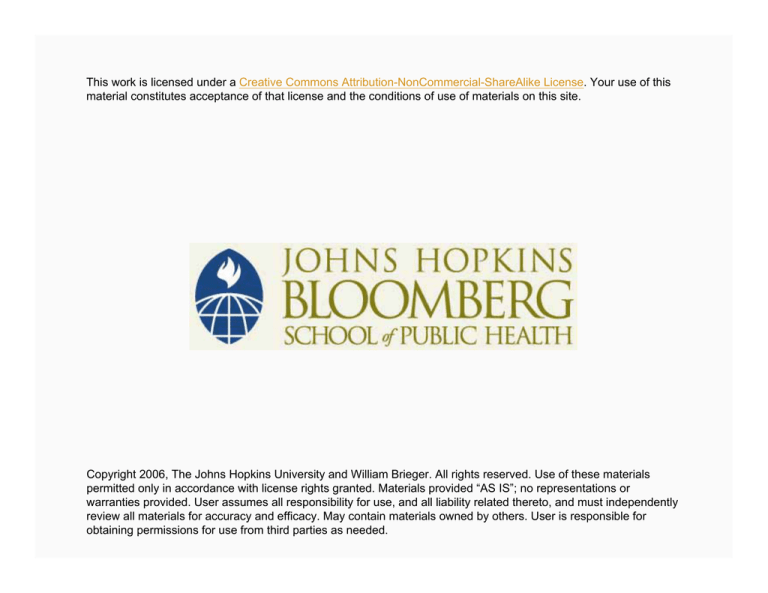
This work is licensed under a Creative Commons Attribution-NonCommercial-ShareAlike License. Your use of this
material constitutes acceptance of that license and the conditions of use of materials on this site.
Copyright 2006, The Johns Hopkins University and William Brieger. All rights reserved. Use of these materials
permitted only in accordance with license rights granted. Materials provided “AS IS”; no representations or
warranties provided. User assumes all responsibility for use, and all liability related thereto, and must independently
review all materials for accuracy and efficacy. May contain materials owned by others. User is responsible for
obtaining permissions for use from third parties as needed.
Recruitment and Involvement of Trainees
William Brieger, MPH, CHES, DrPH
Johns Hopkins University
Who Participates? Who Decides?
Is training
organized …
Ë In-house?
Ë Externally?
(if an
invitation
is received)
Continued
3
Who Participates? Who Decides?
Criteria: formal and informal
Ë Who is eligible according
personnel policy?
Ë Who is qualified in technical terms?
Ë Who has influence, connections, or seniority?
Ë Whose “turn” is it?
4
What Are the Incentives to Attend Training?
Both professional and personal
Ë Linked with promotion criteria
Ë Opportunity for self-actualization
Ë Travel and per diem are enticing
Ë Workshops offer a chance to SHOP
Ë Recognition upon return
Sometimes the wrong people attend for the wrong
reasons
5
And What Happens on Return?
Are there opportunities to practice new skills?
Ë Is there policy and supervisory support?
Ë Are there adequate resources?
Will there be jealousy and lack of cooperation among coworkers?
Can multiplier effects be achieved by sharing and
training others?
6
Ensuring Appropriate Recruitment
Spell out very clearly
in all promotional
literature
ËThe desired
qualifications of
potential trainees
ËWhat the trainee is
expected to do upon
returning to work
Nurse aides are often trained
on the job in private clinics;
they are least likely to receive
training unless organizers
specify their attendance
7
Appropriate Recruitment
Communicate well in advance with agencies that will be
sending trainees so that management:
Ë Perceives a need for the training
Ë Develops a personal interest in the course and
Ë Expects successful performance from anyone it
sends for training
Continued
8
Appropriate Recruitment
Work with the management to make training selection a
joint process between the trainers and the agency
sending trainees
Make it clear that trainees must apply for a place in the
course and that their applications will be screened
Spell out the criteria for screening and selection
Actually apply the criteria
9
Recruiting Volunteers
Expectations must be:
Ë Realistic in terms of time, other costs, abilities
Ë Developed in concert with:
x Populations the volunteers will serve
x Professional staff with whom volunteers
will work
Continued
10
Recruiting Volunteers
Communicated clearly to:
Ë Those selecting the volunteer
Ë The volunteers themselves
11
Communities and Agencies: Differing Expectations?
Both want primary
care to reach
grassroots
Agency expects
management of
village drug kit
Villagers expect that volunteer will have opportunity to
improve himself
Conflicts may result
12
Two Aspects of Involvement
In the learning process
Ë Adult learning principles
x What I hear, I forget
x What I see, I remember
x What I do, I understand
Continued
13
Two Aspects of Involvement
In the planning process
Ë The training
committee
Ë Trainee
responsibilities for
their own learning
environment
14
Training Patent Medicine Vendors
Igbo-Ora, a town of
50,000
Ë 50 PMV shops
PMVs had trade
association/guild
Opportunities for training
explained at an
association meeting
Photo by John Oribhaboise
15
Training Committee
Association appointed a
five-member training
committee to work with the
trainers
Committee polled
members interests
Continued
16
Training Committee
Trainers conducted
survey and shared results
with committee
Committee decided on
curriculum
17
Committee Action
Planned times and
found venue (school)
Printed handout
materials
Set up the venue
each session
Kept attendance,
encouraged participation
Handled review and
evaluation
18












